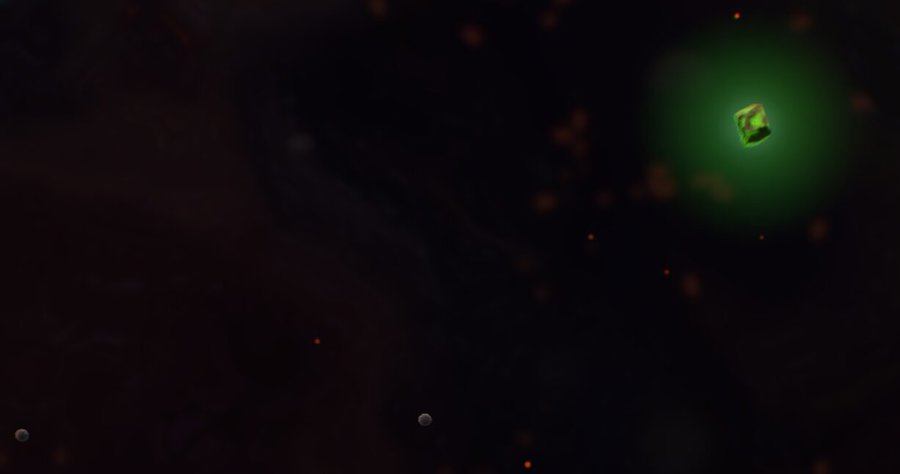Devblog #46: (Environmental) Tolerances Update

Environmental interactions get a lot more varied in this new latest version of Thrive. The first major change is that there are now environmental tolerances to consider. This means that your species needs to be adapted to the conditions of the environment you want to live in: temperature, pressure, UV, and even the presence of oxygen. Also added are new environmental chunks like the radioactive chunk shown in the first image. It will cause damage to microbes that cannot resist radiation.
Also in this release we finally have a fully finished thermosynthesis gameplay, though it might not be exactly fully balanced yet as we didn't get that much balance feedback on the public test build last week. And of course along with the major new features we have a ton of small tweaks, graphics and GUI improvements as well as bug fixes. One highlight is that we now have an exclusive fullscreen option which should help anyone wanting to play in fullscreen mode on Windows.
As always the update is available for free with our launcher, or you can support development by purchasing on Steam or Itch.io. We really need your support in order to continue development after the microbe stage is complete. We plan to focus on completing the microbe stage this year. But after that we may not have enough money to continue the development at the current speed into the multicellular stage and beyond if we don't get more support.
Read on for more details, or visit the download page linked below to get the new version.
Thrive 0.8.1
Freezing, Crushed, And Overheating - Environmental Tolerances
A long awaited feature, environmental tolerances are now implemented in Thrive. Life in Thrive now must adapt to different conditions across their planet, simulating an important aspect of your species' evolutionary story.
There is now a section of the editor devoted to environmental tolerances, where players will be able to examine and control their preferred environmental conditions. Inhabit a patch with unfavorable conditions, and you will suffer penalties in gameplay and auto-evo performance. Adapt well to a patch, and gameplay bonuses will be received by your species.

This feature will make patch migration and player movement more strategic in nature, and - combined with other features in 0.8 - will provide an engaging simulation of life’s story on a young, changing planet. Balancing is an important part of making this feature as fun as possible, so feedback is deeply appreciated on either our our community forums or community Discord.
Radiation-Eating Cells

Be wary of a strange, green light: radiotrophy is finally in Thrive.
Radiotrophy - a unique metabolic strategy undertaken by some fungal species here on Earth - involves the generation of energy from captured radioactivity. In Thrive, we have introduced radioactive chunks, found in hydrothermal vents and caves.
Absorbing too much radiation is dangerous, especially to unadapted cells - however, cells with melanosomes are able to metabolize a certain amount of radiation, providing a powerful source of energy. Be careful though: even cells with melanosomes can overdo it. Though, with enough melanosomes extreme amounts of radiation can be overcome.
Along with being an engaging metabolic pathway, radioactive material also serves as an interesting environmental hazard. So if your organism lives in a patch with radioactive material, tread carefully!
Full Thermosynthesis Implementation

Along with radiotrophy, thermosynthesis represents another unique metabolic pathway added to Thrive.
Thermosynthesis generally involves the use of heat gradients in order to generate energy. In Thrive, players with thermosynthesizing proteins are now able to toggle a thermal display of their environment showing local fluctuations in temperature. Players must navigate between cold and warm spots in order to generate energy - going from colder to warmer spots specifically generates energy.
Thermosynthesis is currently a theoretical diet, and thus is only accessible in non-LAWK playthroughs (toggleable setting when starting a game). However, thermosynthesis is theorized to have been very important for the most ancient of lifeforms on Earth - so future research might make this diet available in a standard, LAWK Thrive playthrough.
One of our developers evolved an organism fully dependent on radiotrophy and thermosynthesis, calling it an exciting yet challenging existence. We challenge our community members to replicate such a fad diet!
Improved Patch Map

Some work has been put into our patch map to better increase player accessibility. Most notably, connections between patch regions are now much more visible, allowing players to better understand where to move in order to escape a region. Graphs in the report have also been moved around in a way approximating importance in order to increase readability.
Additional Features
Added microbe background blur and enabled distortion effect by default
Added an option to select between the different fullscreen modes supported by Godot Engine. When using exclusive fullscreen mode this fixes a one pixel border problem on Windows.
Late multicellular was split into its own full stage: Macroscopic
Implemented multicellular organism statistics panel
Various improvements to auto-evo to allow it to evolve new organelles / upgrades. And improved the microbe AI to be able to use newer features of the game.
Fixes to the organelle suggestions feature to make it not suggest the nucleus too early
Improved cell image generation to make it less likely for the images to be cutoff
Tutorial and Thriveopedia tips page improvements
A full list of changes is available in our release notes on GitHub.
What’s Next
As always remember to join us for our developer Thrivestream later today, where we’ll cover the changes in this release and answer any questions you might have about the future of development. We'll also answer the usual question of what's coming in the next releases. You can visit our feedback thread to give your thoughts on this update. And to report the sure-to-still-exist bugs in the tolerances system.
p.s. if someone missed our previous art contest, the results were published here.






